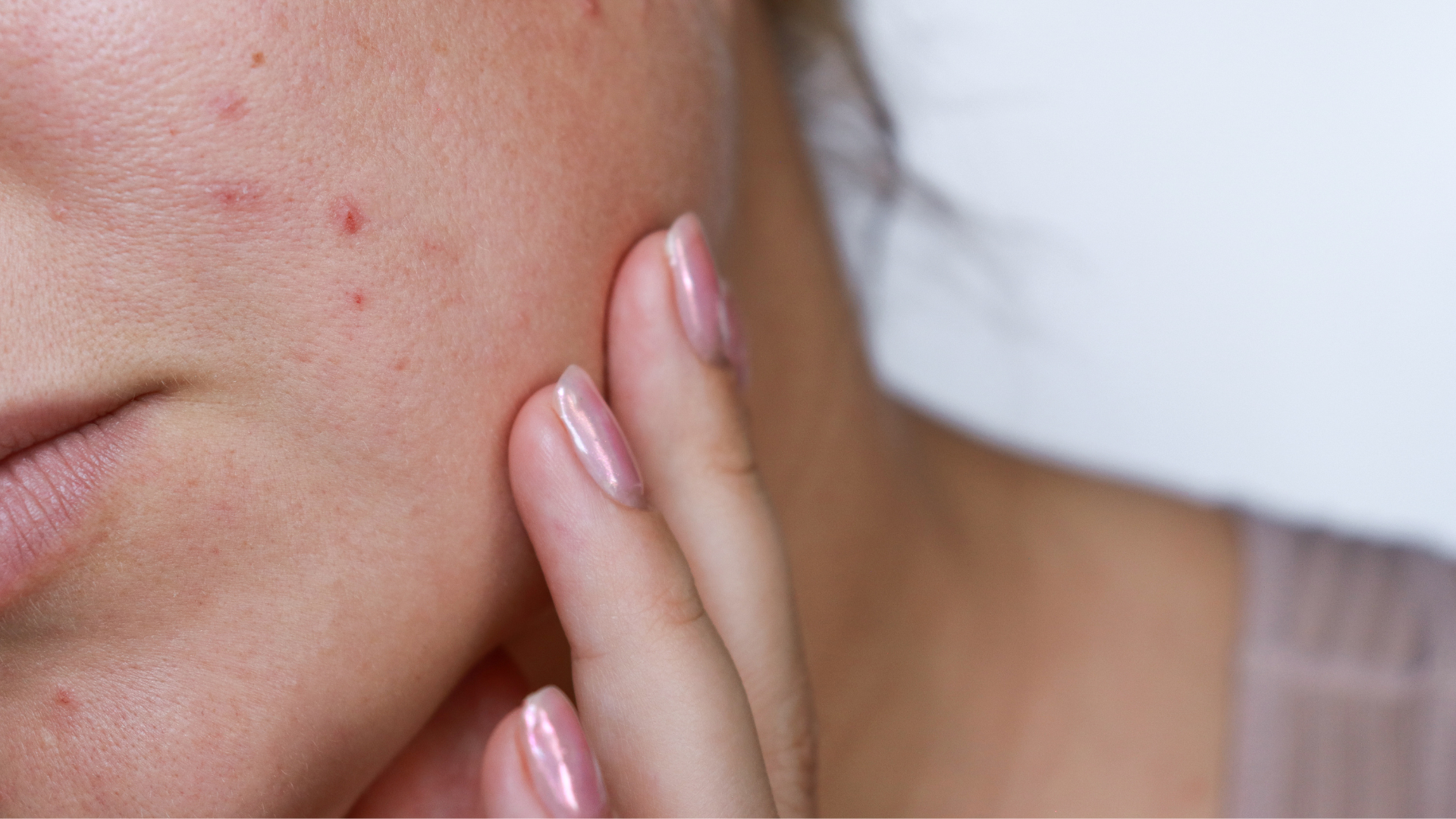Breaking Down Breakouts: The Different Types of Acne and How to Treat Them

Previously, we talked about why treating acne early matters and how everyday care can make a big difference. But acne isn’t one-size-fits-all—it comes in many forms, each with its own causes and quirks. From tiny white bumps to deep, painful cysts, every type develops differently and needs its own kind of care.
Knowing what kind you have (and where it appears) is the first step to finding what actually works for your skin. Whether it shows up on your face, chest, or back, clearer skin starts with understanding your skin—and treating it thoughtfully. It can develop as any (or a combination) of these:
Whiteheads (Closed Comedones)
Whiteheads form when excess oil and dead skin cells build up, clogging the opening of a pore. This creates a small, raised bump that looks white or flesh-colored, appearing to be filled with a white or yellowish substance. They’re most common on the cheeks, chin, and around the mouth, where skin tends to be thinner.
How to treat them:
Resist the urge to pop them! Picking can push bacteria deeper and cause more breakouts. Instead, use products with salicylic acid or adapalene (a gentle retinoid) to help unclog pores and prevent new whiteheads from forming. Consistent exfoliation and lightweight, oil-free products will also help keep pores clear.
Blackheads (Open Comedones)
Blackheads form the same way as whiteheads, forming clogged pores filled with oil and dead skin, but the difference is that the pore remains open and widens as buildup accumulates. When the trapped oil oxidizes from air exposure, it turns dark, creating the tiny black dots most often seen on the nose, forehead, and back.
How to treat them:
A topical retinoid, like adapalene, is your best defense. Retinoids work deep within pores to increase cell turnover and prevent buildup. Avoid squeezing blackheads—doing so can cause irritation, scarring, or infection. Regular use of chemical exfoliants like salicylic acid can also keep pores clear over time.
Papules and Pustules (aka Pimples)
When excess oil, dead skin cells, and bacteria get trapped inside a pore, the area becomes inflamed—resulting in red, swollen bumps. A pimple without pus is called a papule. Papules are solid, red, and tender, without visible pus. If the pimple contains pus, it’s called a pustule. Pustules are similar but contain white or yellow pus at the center.
How to treat them:
Look for acne products that contain benzoyl peroxide, azelaic acid, or retinoids. Benzoyl peroxide helps reduce acne-causing bacteria, while azelaic acid targets redness and discoloration. Consistency is key—spot-treating helps, but a balanced full-face regimen will prevent new pimples from forming.
Nodules and Cysts
When acne inflammation runs deep beneath the skin, it can form large, painful bumps called nodular or cystic lesions. Nodules are firm and solid, while cysts are filled with pus and feel softer. Because these breakouts go deep into the skin, they can feel tender or painful. These types of acne often take longer to heal and carry a higher risk of scarring.
How to treat them:
Here is where a dermatologist’s expertise makes all the difference. Deep cystic acne often needs prescription treatments—like oral antibiotics, hormonal therapy, or isotretinoin—to reduce inflammation and prevent long-term scarring. In some cases, dermatologists may inject the cyst with a small dose of corticosteroid to quickly relieve pain and swelling.
Where Acne Shows Up
Acne doesn’t stop at your face—it can appear on your chest, shoulders, back, scalp, and even around the hairline. Each area behaves differently, so how you treat it matters just as much as where it appears.
Facial Acne (Acne Vulgaris)
The most common form of acne, facial acne—also called acne vulgaris—usually starts around puberty and can continue into adulthood. Hormones, stress, and lifestyle habits can all play a part.
Treatment tip: Stick with a consistent skincare routine that includes gentle cleansing, exfoliation, and acne-fighting ingredients like salicylic acid or adapalene. If breakouts become severe or persistent, a dermatologist can help you adjust your regimen or add prescription options.
Back and Chest Acne (Truncal Acne)
When acne spreads beyond the face, it’s called truncal acne. These breakouts can be deeper, more painful, and more likely to scar due to thicker skin and friction from clothing or workouts.
Treatment tip: Use a salicylic acid or benzoyl peroxide body wash in the shower, and wear breathable fabrics that let your skin stay dry. If truncal acne doesn’t respond to over-the-counter care, a dermatologist may recommend oral medications or light-based treatments.
Forehead Acne
Often linked to hair products, oil buildup, or sweat, forehead acne can flare up if you use heavy conditioners, wear hats or headbands, or go too long between washes.
Treatment tip: Keep hair clean and avoid letting oily hair products touch your skin. Look for non-comedogenic styling products, and cleanse your forehead gently after sweating or wearing headgear.
Scalp Acne
Less common but definitely frustrating, scalp acne can feel sore and itchy. It’s usually caused by excess oil, buildup, or hair products clogging follicles.
Treatment tip: Try a medicated shampoo with salicylic acid, zinc, or ketoconazole, and avoid heavy oils that can coat the scalp. If irritation or pain worsens, a dermatologist can prescribe targeted topical or oral treatment.
Acneiform Eruptions
These look like acne, but aren’t true acne. They’re usually triggered by external factors like certain medications, thick creams, oils, or even tight clothing.
Treatment tip: Once the cause is identified, the first step is simply removing it. Let your skin breathe, switch to non-comedogenic products, and allow a few weeks for your skin to recover.
Special Types of Acne
Some breakouts don’t fit the usual pattern. These “special” types of acne are becoming more common—and understanding what’s behind them can help you treat them smarter.
Acne Cosmetica
This type of acne comes from makeup or skincare products that clog pores. It’s often seen along the hairline, cheeks, and jawline.
Treatment tip: Simplify your routine, stick with non-comedogenic products, and make sure to thoroughly cleanse your skin every night. Sometimes, less really is more.
Maskne (Mask Acne)
The humid, trapped environment under masks can create the perfect conditions for breakouts. Friction, sweat, and bacteria can all play a part.
Treatment tip: Change your mask regularly, opt for breathable cotton fabrics, and cleanse your face before and after wearing one. Lightweight moisturizers with niacinamide or ceramides can help protect your skin barrier.
Oil Acne
Too much oil—either from the skin or from external sources like facial or hair oils—can clog pores and lead to breakouts.
Treatment tip: Avoid heavy oils, and try double cleansing: start with an oil cleanser to remove makeup and sunscreen, followed by a gentle foaming cleanser to lift away residue.
Drug-Induced Acne
Some medications can cause acne-like breakouts as a side effect. This includes steroids, lithium, certain vitamins, and thyroid or antibiotic treatments.
Treatment tip: Don’t stop prescribed medication without medical guidance. Talk to your doctor or dermatologist—they can often adjust your dosage or help you manage the side effects safely.
The Four Grades of Acne Severity
Not all acne is equally intense, and dermatologists often organize it into four grades to help guide treatment plans.
Grade 1: The mildest type of acne, at its earliest stages, includes only comedones (whiteheads and blackheads). Early treatment and good skincare can prevent worsening.
Grade 2: Comedones with some papules or pustules. Inflammation starts here, so active treatment is important to prevent the formation of scars and spots.
Grade 3: The stage where severe acne begins. Consists of deep papules and nodules that require professional care to prevent skin damage.
Grade 4: Large, painful cysts and nodules, consisting of the most severe form of acne. This form requires aggressive acne treatment and close dermatologist supervision.
Treatment Option Overview
Once again, acne treatment isn’t one-size-fits-all. The best results come from combining daily care with professional guidance, depending on severity.
1. Skincare Routine. Gentle cleansing, toning, moisturizing, and exfoliating form the foundation of clear skin. Consistency matters more than intensity—avoid harsh scrubs or over-cleansing.
2. Over-the-Counter (OTC) Treatments. Look for benzoyl peroxide, salicylic acid, or alpha hydroxy acids to manage mild to moderate acne. OTC products are a great first step, but may plateau over time.
3. Prescription Topicals. Dermatologists may recommend retinoids, antibiotics (like clindamycin), or azelaic acid for stronger results. These target bacteria, oil, and inflammation directly at the source.
4. Oral Medications. For more persistent acne, oral antibiotics, hormonal therapy, or isotretinoin may be prescribed. These treatments target deeper internal causes like hormones or chronic inflammation.
5. In-Clinic Procedures. Professional treatments can accelerate results and improve texture. Options include chemical peels to exfoliate and renew skin, laser or light therapy to reduce bacteria and inflammation, and comedone extraction for clogged pores.
6. At-Home Remedies. Natural care can complement medical treatment—try gentle options like aloe vera, tea tree oil, or a low-glycemic diet to support clearer skin from within.
Every breakout tells a story—what matters most is how you listen to your skin. Understanding your acne type helps you choose care that works with your skin, not against it. Let’s help you find your glow. Book a consultation with Beautyfluff today!



Comments